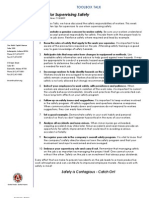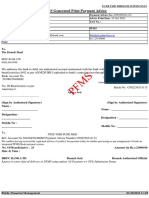0 ratings0% found this document useful (0 votes)
24 viewsCPNI Campaign2 - Checklist - FINAL LOW RES - EXTRANET
CPNI Campaign2 - Checklist - FINAL LOW RES - EXTRANET
Uploaded by
AbubakerCopyright:
© All Rights Reserved
Available Formats
Download as PDF, TXT or read online from Scribd
CPNI Campaign2 - Checklist - FINAL LOW RES - EXTRANET
CPNI Campaign2 - Checklist - FINAL LOW RES - EXTRANET
Uploaded by
Abubaker0 ratings0% found this document useful (0 votes)
24 views1 pageOriginal Title
CPNI Campaign2_Checklist_FINAL LOW RES- EXTRANET
Copyright
© © All Rights Reserved
Available Formats
PDF, TXT or read online from Scribd
Share this document
Did you find this document useful?
Is this content inappropriate?
Copyright:
© All Rights Reserved
Available Formats
Download as PDF, TXT or read online from Scribd
Download as pdf or txt
0 ratings0% found this document useful (0 votes)
24 views1 pageCPNI Campaign2 - Checklist - FINAL LOW RES - EXTRANET
CPNI Campaign2 - Checklist - FINAL LOW RES - EXTRANET
Uploaded by
AbubakerCopyright:
© All Rights Reserved
Available Formats
Download as PDF, TXT or read online from Scribd
Download as pdf or txt
You are on page 1of 1
LINE MANAGER’S CHECKLIST
Here’s the thing about security….
1. IT COMES WITH THE JOB 7. LEAD FROM THE FRONT
Ensuring that your team behaves in a It’s important that you walk the walk and
security-conscious way is as much a part of don’t belittle security matters. Employees
your responsibilities as monitoring their need to see you employ good security
performance or looking after their welfare. practice in everything you do. So take the
lead and behave in the way you expect your
2. KNOW YOUR STAFF staff to behave.
Understanding the motivations and concerns
of your team will help you recognise when 8. DON’T WORRY, DON’T PANIC
there’s a problem and address any issues. Ensure you know how to handle a security
incident. Try and be confident when an-
3. EXPLAIN THE THREAT swering questions about security concerns
Don’t assume everyone knows why secu- and always show you’re taking the situa-
rity is important. Help them understand tion seriously.
the potential threats they face, the value
of your organisation’s assets and the con- 9. IT’S A TWO-WAY STREET
sequences of a breach. Gather feedback from staff – do they know
the threats, and the behaviour expected of
4. TELL THEM WHAT YOU EXPECT them? Do they have security-related ideas
OF THEM that you and others could try?
Check that employees understand and
can follow your organisation’s security 10. IT’S ALWAYS A LEARNING
procedures. Where relevant, don’t leave CURVE
briefings or training to another team – Security is an ever-evolving issue.
take charge of this yourself. Staff should be encouraged to own
up to mistakes. Learning about and
5. MAKE IT FEEL REAL understanding the implications of real-life
The best way to get someone to do examples can help all of the team.
something is to show them how it affects
them personally. Use case studies and 11. MANAGE ACCESS
tangible examples to keep briefings You may need help from IT on this. Keep
interesting and engaging. a record of employees’ access rights and
remember to close down that access when
6. KEEP KNOWLEDGE TOPPED UP they move on.
Security measures can change regularly in
response to evolving threats. In addition, 12. AND LASTLY…
staff working in new areas or new systems Remember that while it’s important you
may need a top-up security briefing. Keep keep your team aware of security matters,
your staff updated on changes to security maintaining security is ultimately down to
policies and ensure they receive a security the choices that individuals make.
briefing when they’re given access to new
systems, visit new sites or have been issued SECURITY IS EVERYONE’S BUSINESS.
with new devices.
TOGETHER, WE’VE GOT IT COVERED
© CROWN COPYRIGHT 2015 CPNI Security Behaviours Campaign: The role of line management
You might also like
- 2023 Tesla Impact ReportDocument160 pages2023 Tesla Impact ReportSimon AlvarezNo ratings yet
- Visible Felt Leadership and Operating DisciplineDocument3 pagesVisible Felt Leadership and Operating Disciplinemuhammad_hatta_adam0% (1)
- The Supervisor A Key Ally To Workplace SafetyDocument2 pagesThe Supervisor A Key Ally To Workplace SafetyMiguel GonzalesNo ratings yet
- Supervisor Safety Training: What It Takes To Inspire Your People To Work SafeDocument26 pagesSupervisor Safety Training: What It Takes To Inspire Your People To Work SafeshahidNo ratings yet
- Qualities of A Great HSE ProfessionalDocument3 pagesQualities of A Great HSE ProfessionalInnocent BhaikwaNo ratings yet
- S943 Young Worker Services PDFDocument1 pageS943 Young Worker Services PDFYolanda Ivette Peña MoralesNo ratings yet
- Gallobay PerspectevisDocument1 pageGallobay PerspectevisHeartyscorpionNo ratings yet
- Supervisor Safety TrainingDocument26 pagesSupervisor Safety TrainingMutiaNo ratings yet
- Safety InductionDocument2 pagesSafety InductionPrimelift Safety Resources LimitedNo ratings yet
- Workplace Safety Preventing Accidents in The WorkplaceDocument18 pagesWorkplace Safety Preventing Accidents in The WorkplaceNarantsatsralt RavdandorjNo ratings yet
- He Structure of A Safety OrganizationDocument16 pagesHe Structure of A Safety OrganizationArya E VNo ratings yet
- 1182939520bbs Training - RentrustDocument24 pages1182939520bbs Training - Rentrustanand.azadNo ratings yet
- EHS Awareness (Supervisor Safety Offering) - Liberia - July W29, 2020Document10 pagesEHS Awareness (Supervisor Safety Offering) - Liberia - July W29, 2020JonathanNo ratings yet
- The Carebear Stare and The Reading RainbowDocument13 pagesThe Carebear Stare and The Reading RainbowSam WaiteNo ratings yet
- Monroe - 5 StepsDocument4 pagesMonroe - 5 StepsAriff IsaNo ratings yet
- Persuasive SpeechDocument62 pagesPersuasive Speechpiyasak2545No ratings yet
- The 5 Keys To A Safety Mindset - You May Not Live Without ThemDocument5 pagesThe 5 Keys To A Safety Mindset - You May Not Live Without ThemNiti YuangyimNo ratings yet
- Monroe's Motivated Sequence - Communication Skills FromDocument5 pagesMonroe's Motivated Sequence - Communication Skills FromJUSTINENo ratings yet
- 0811 Employee Involvement PDFDocument2 pages0811 Employee Involvement PDFFirman Suryadi RahmanNo ratings yet
- 0811 Employee InvolvementDocument2 pages0811 Employee InvolvementFirman Suryadi Rahman100% (1)
- Habits of Effective Safety ManagersDocument7 pagesHabits of Effective Safety ManagersNiraNo ratings yet
- Perfecting The Call To Act: M.AsifDocument5 pagesPerfecting The Call To Act: M.AsiffaniawanNo ratings yet
- Process Safety and Risk Management: 2. Visible Felt Leadership and Operating DisciplineDocument3 pagesProcess Safety and Risk Management: 2. Visible Felt Leadership and Operating DisciplineAbdul Hai MohammedNo ratings yet
- Module 1 - The Theory of SupervisionDocument17 pagesModule 1 - The Theory of Supervisionmich.cabrera09No ratings yet
- Taking Ownership of SafetyDocument1 pageTaking Ownership of SafetyquadriakinwandeNo ratings yet
- gW3Z7NhhWxtMjipL - 32eGoNlAOUR6vwPk OSHA 10 Construction Module 14 Study GuideDocument5 pagesgW3Z7NhhWxtMjipL - 32eGoNlAOUR6vwPk OSHA 10 Construction Module 14 Study GuideBelkacem BouazzaNo ratings yet
- 12 Ways To Boost Workplace SafetyDocument6 pages12 Ways To Boost Workplace Safetymuhammadarifh4486No ratings yet
- 01 Laboratory Exercise 1Document3 pages01 Laboratory Exercise 1Jane Rose Clemeña Gumban100% (1)
- Ajay QuestionnaireDocument6 pagesAjay QuestionnaireNIRBHAY PANDEYNo ratings yet
- Workplace Safety Standards (Final)Document8 pagesWorkplace Safety Standards (Final)Maheen KhanzadaNo ratings yet
- AlienVault Incident Response GuideDocument48 pagesAlienVault Incident Response GuideMohamadFadiNo ratings yet
- Basic Security Safety Awareness Session PlanDocument8 pagesBasic Security Safety Awareness Session Planraregala.safetyNo ratings yet
- AlienVault Incident Response GuideDocument48 pagesAlienVault Incident Response GuideasdrubalmartinsNo ratings yet
- Leadership Guide - How Listening and Learning Are Our Best Defence - May 2022Document5 pagesLeadership Guide - How Listening and Learning Are Our Best Defence - May 2022Αλέξανδρος ΒασιλειάδηςNo ratings yet
- Safety First 6 Ways To Build A Culture of Accident Prevention PDFDocument2 pagesSafety First 6 Ways To Build A Culture of Accident Prevention PDFFernandoNo ratings yet
- Facilitator Guide: People Make Mistakes'Document3 pagesFacilitator Guide: People Make Mistakes'Hal GhentNo ratings yet
- Chapter 2 - Theat & Risk AssessmentDocument88 pagesChapter 2 - Theat & Risk AssessmentLemur CattaNo ratings yet
- Hazard Register ConstructionDocument15 pagesHazard Register ConstructionMohd ObaidullahNo ratings yet
- AlienVault Incident Response GuideDocument46 pagesAlienVault Incident Response GuideRichardNo ratings yet
- Behaviour Based Safety: The ABC's of BBSDocument8 pagesBehaviour Based Safety: The ABC's of BBSWiZofFaTeNo ratings yet
- Safety 7 PDFDocument12 pagesSafety 7 PDFAjejejeNo ratings yet
- AAVisible Felt LeadershipDocument22 pagesAAVisible Felt LeadershipMariana BatalimNo ratings yet
- 5 Step Guide Safety ConversationDocument7 pages5 Step Guide Safety ConversationSazones Perú Gerardo SalazarNo ratings yet
- Safety CultureDocument5 pagesSafety CultureprisignsNo ratings yet
- UntitledDocument4 pagesUntitledRobert Angelo BravoNo ratings yet
- Contractors - Captain of the TeamDocument10 pagesContractors - Captain of the TeamTshepiso MotauNo ratings yet
- 10 Practice For OSHADocument3 pages10 Practice For OSHAsyahrulsharunNo ratings yet
- The 5A-Way To Safety: (Management's Role in Safety)Document26 pagesThe 5A-Way To Safety: (Management's Role in Safety)EPOUNo ratings yet
- Work Immersion Module 2Document5 pagesWork Immersion Module 2pattiffanylorenzo278No ratings yet
- ToolboxTalk 0715Document2 pagesToolboxTalk 0715Epifanio Jr Lagadan TorresNo ratings yet
- MBMA Lunch and Learn - Safety Culture 042214rev 2Document17 pagesMBMA Lunch and Learn - Safety Culture 042214rev 28dvmhcgt28No ratings yet
- 52tips For Safety TrainersDocument22 pages52tips For Safety TrainersVicki LibreightNo ratings yet
- safety-sampleDocument2 pagessafety-sampledpaital172No ratings yet
- Conducting Toolbox Meeting HSE Presentation HSE FormatsDocument14 pagesConducting Toolbox Meeting HSE Presentation HSE FormatsTALHA AHMAD FAROOQINo ratings yet
- Leader Ship Safety TrainingDocument147 pagesLeader Ship Safety TrainingYanuar Prayoga100% (1)
- Human Elements in Safety: Safety Organization of The Philippines, IncDocument23 pagesHuman Elements in Safety: Safety Organization of The Philippines, IncJulio GregorioNo ratings yet
- 5 Min SafeWorkHabits 11Document3 pages5 Min SafeWorkHabits 11SamuelNo ratings yet
- Sts Howto3083 Supervisor Safety V2-Web-Nov-2015Document3 pagesSts Howto3083 Supervisor Safety V2-Web-Nov-2015Suresh DevarajanNo ratings yet
- Toolbox MeetingDocument14 pagesToolbox MeetingEbenezer DonkohNo ratings yet
- HSE-BMS-005 Conducting Toolbox MeetingDocument14 pagesHSE-BMS-005 Conducting Toolbox MeetingShahid AlamNo ratings yet
- The Art of Risk Management: Learn to Manage Risks Like a ProFrom EverandThe Art of Risk Management: Learn to Manage Risks Like a ProRating: 3 out of 5 stars3/5 (1)
- CPNI - Campaign 2 - Line Managers SlidesDocument12 pagesCPNI - Campaign 2 - Line Managers SlidesAbubakerNo ratings yet
- Contractor Safety Health Awareness Overvirew EnglishDocument42 pagesContractor Safety Health Awareness Overvirew EnglishAbubaker100% (1)
- 2.7.1 Security Management Annual Report 3rd AugDocument17 pages2.7.1 Security Management Annual Report 3rd AugAbubakerNo ratings yet
- Selecting The Type of Hia To Conduct RevDocument1 pageSelecting The Type of Hia To Conduct RevAbubakerNo ratings yet
- Power of AdvocacyDocument1 pagePower of AdvocacyAbubakerNo ratings yet
- Increasing Student MotivationDocument18 pagesIncreasing Student MotivationAbubakerNo ratings yet
- Improve Your Grades - Study Skills and Test TakingDocument29 pagesImprove Your Grades - Study Skills and Test TakingAbubakerNo ratings yet
- Fusion Fin GLDocument7 pagesFusion Fin GLjaleelmohamedfNo ratings yet
- Chapter 3 Brand CommunicationDocument10 pagesChapter 3 Brand Communicationlkvy.work.ouNo ratings yet
- Ch16 262-266Document5 pagesCh16 262-266Sajid AliNo ratings yet
- Aud689 Test Nov 2020 QuestionsDocument2 pagesAud689 Test Nov 2020 QuestionsnurulsyafiqahNo ratings yet
- Bộ Đề READ ALOUDDocument4 pagesBộ Đề READ ALOUDNguyễn NgaNo ratings yet
- DepreciationDocument4 pagesDepreciationfasalieconteh375No ratings yet
- VR 14-01 Supplier TC en 1090 Ce Marking Issue 1-15Document7 pagesVR 14-01 Supplier TC en 1090 Ce Marking Issue 1-15Bryan GonzalesNo ratings yet
- 1.0. Intro To MNCDocument36 pages1.0. Intro To MNCNatasha AzzariennaNo ratings yet
- AFS ProjectDocument28 pagesAFS ProjectAnam AbrarNo ratings yet
- History of SignagesDocument2 pagesHistory of Signagesnaeem.soomro13No ratings yet
- Why Freshsales Suite Is Better Than HubspotDocument11 pagesWhy Freshsales Suite Is Better Than HubspotVilas.pNo ratings yet
- M Management by Thomas S. BatemanDocument449 pagesM Management by Thomas S. BatemanreyaankpatelNo ratings yet
- View Invoice - ReceiptDocument1 pageView Invoice - ReceiptJohn Francis KanwaiNo ratings yet
- Municipal Trial Court in Cities: PlaintiffDocument19 pagesMunicipal Trial Court in Cities: PlaintiffLably ReuyanNo ratings yet
- Business Combination ExercisesDocument5 pagesBusiness Combination ExercisesmmNo ratings yet
- PrintPaymentAdvice 38Document2 pagesPrintPaymentAdvice 38DTO HailakandiNo ratings yet
- Ra10607-Flowchart-Elements of An Insurance ContractDocument1 pageRa10607-Flowchart-Elements of An Insurance Contractwords of Ace.No ratings yet
- Market NeedsDocument14 pagesMarket NeedsDuy TrácNo ratings yet
- File 1Document10 pagesFile 1Ngek NgokNo ratings yet
- Acc 0000034540 Aug13 PDFDocument2 pagesAcc 0000034540 Aug13 PDFPrasanth ViratNo ratings yet
- Lec 3: Industry Transformation: Dr. M.K.Satish EmailDocument20 pagesLec 3: Industry Transformation: Dr. M.K.Satish EmailNISHANT BANKANo ratings yet
- FR1 2022 - Tutpack For PrintingDocument26 pagesFR1 2022 - Tutpack For PrintingkhavisaniNo ratings yet
- No Researcher and Year Title Research Variable Analysis Tool and Unit Result of ResearchDocument1 pageNo Researcher and Year Title Research Variable Analysis Tool and Unit Result of ResearchRisang SuprayogaNo ratings yet
- Assessment & AuditDocument24 pagesAssessment & Audit9punitagrawalNo ratings yet
- Pranav Sir - Maths Formula Book - Dec 2022 PDFDocument6 pagesPranav Sir - Maths Formula Book - Dec 2022 PDFSiddhi GuptaNo ratings yet
- Fee Remission DocumentDocument4 pagesFee Remission DocumentAadhishwar ReddyNo ratings yet
- Internship EvaluationDocument12 pagesInternship EvaluationSonu PurbeyNo ratings yet
- French Wine Industry Research PaperDocument42 pagesFrench Wine Industry Research PaperSaurabh Krishna SinghNo ratings yet
- Vandon Orginal, How To Market A Refrigerator in AntarticaDocument17 pagesVandon Orginal, How To Market A Refrigerator in Antarticadany2884bcNo ratings yet
































































































